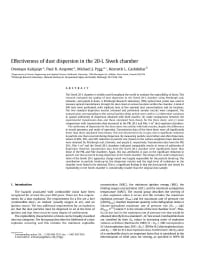Mining Publication: Effectiveness of Dust Dispersion in the 20-L Siwek Chamber
Original creation date: January 2010
Authors: O Kalaejaiye, PR Amyotte, MJ Pegg, KL Cashdollar
NIOSHTIC2 Number: 20036508
J Loss Prev Process Ind 2010 Jan; 23(1):46-59
NIOSHTIC2 Number: 20031122
Proceedings of the Sixth International Symposium on Hazards, Prevention, and Mitigation of Industrial Explosions (Halifax, NS, Canada, Aug. 27 - Sept. 1, 2006), Halifax, Canada: Dalhousie University, 2006 Aug; 1:253-278
The Siwek 20-L chamber is widely used throughout the world to evaluate the explosibility of dusts. This research evaluated the quality of dust dispersion in the Siwek 20-L chamber using Pittsburgh coal, Gilsonite, and purple K dusts. A Pittsburgh Research Laboratory (PRL) optical dust probe was used to measure optical transmittance through the dust cloud at various locations within the chamber. A total of 540 tests were performed, with triplicate tests at five nominal dust concentrations and six locations. The two standard dispersion nozzles (rebound and perforated annular nozzle) were compared. The transmissions corresponding to the normal ignition delay period were used to: (a) determine variations in spatial uniformity of dispersion obtained with both nozzles; (b) make comparisons between the experimental transmission data and those calculated from theory for the three dusts; and (c) make comparisons with transmission data measured in the PRL 20-L and Fike 1-m3 dust explosion chambers. The uniformity of dispersion for the three dusts was similar with both nozzles, despite the differences in nozzle geometry and mode of operation. Transmission data of the three dusts were all significantly lower than those calculated from theory. This was discovered to be, in part, due to significant reduction in particle size that occurred during dispersion. By measuring particle sizes before and after dispersion, values of 60%, 50%, and 20% reduction in particle size (based on the surface-weighted mean diameter) were obtained for Pittsburgh coal, Gilsonite, and purple K, respectively. Transmission data from the PRL 20-L, Fike 1-m3 and the Siwek 20-L chambers indicated comparable results in terms of uniformity of dispersion. However, transmission data from the Siwek 20-L chamber were significantly lower than those of the PRL and Fike chambers. Again, this was attributed, in part, to the significant reduction in particle size that occurred during dispersion in the Siwek chamber. The design of the outlet (dispersion) valve of the Siwek 20-L apparatus charge vessel was largely responsible for the particle break-up. The contribution to particle break-up by the dispersion nozzles and the high level of turbulence in the chamber were found to be minimal. This is a significant finding in that the dust particle size tested for explosibility in the Siwek chamber is considerably smaller than the original dust sample.

NIOSHTIC2 Number: 20036508
J Loss Prev Process Ind 2010 Jan; 23(1):46-59
NIOSHTIC2 Number: 20031122
Proceedings of the Sixth International Symposium on Hazards, Prevention, and Mitigation of Industrial Explosions (Halifax, NS, Canada, Aug. 27 - Sept. 1, 2006), Halifax, Canada: Dalhousie University, 2006 Aug; 1:253-278
- Airborne Dust Liberation During Coal Crushing
- Coal Dust Explosibility Meter Evaluation and Recommendations for Application
- Coal-Dust Explosion Tests in the Experimental Mine 1919 to 1924, Inclusive
- Differential Pressure Response of 25-mm-Diameter Glass Fiber Filters Challenged with Coal and Limestone Dust Mixtures
- Evaluation of LIDAR as a Novel Remote Dust Sensing Technology
- Full-Scale Testing of the Float Dust Deposition Meter
- Rock Dusting Considerations in Underground Coal Mines
- Status of a Tapered Element, Oscillation Microbalance-Based Continuous Respirable Coal Mine Dust Monitor
- Technology News 515 - Float Coal Dust Explosion Hazards
- Test Report on the Machine-Mounted Continuous Respirable Dust Monitor